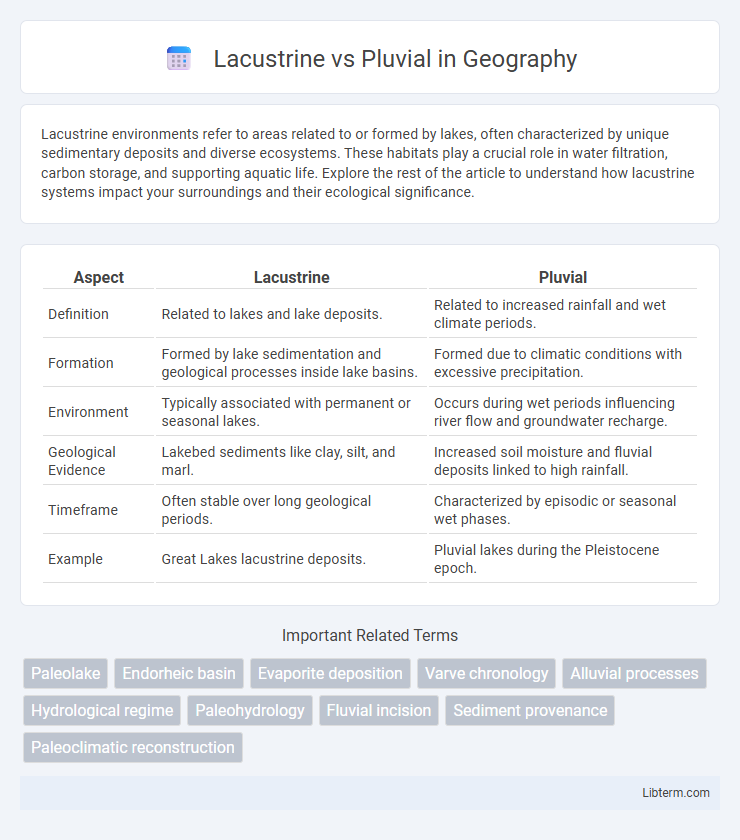Lacustrine environments refer to areas related to or formed by lakes, often characterized by unique sedimentary deposits and diverse ecosystems. These habitats play a crucial role in water filtration, carbon storage, and supporting aquatic life. Explore the rest of the article to understand how lacustrine systems impact your surroundings and their ecological significance.
Table of Comparison
| Aspect | Lacustrine | Pluvial |
|---|---|---|
| Definition | Related to lakes and lake deposits. | Related to increased rainfall and wet climate periods. |
| Formation | Formed by lake sedimentation and geological processes inside lake basins. | Formed due to climatic conditions with excessive precipitation. |
| Environment | Typically associated with permanent or seasonal lakes. | Occurs during wet periods influencing river flow and groundwater recharge. |
| Geological Evidence | Lakebed sediments like clay, silt, and marl. | Increased soil moisture and fluvial deposits linked to high rainfall. |
| Timeframe | Often stable over long geological periods. | Characterized by episodic or seasonal wet phases. |
| Example | Great Lakes lacustrine deposits. | Pluvial lakes during the Pleistocene epoch. |
Introduction to Lacustrine and Pluvial Systems
Lacustrine systems refer to environments dominated by lakes and associated sediment deposits, typically characterized by standing freshwater ecosystems formed through geological processes like glaciation or tectonic activity. Pluvial systems, on the other hand, arise from periods of increased rainfall and moisture, often leading to expanded lake basins and altered hydrological regimes during wet climatic intervals known as pluvials. Understanding the sedimentology and hydrology of lacustrine and pluvial systems is crucial for reconstructing paleoclimatic conditions and assessing water resource dynamics in arid and semi-arid regions.
Definitions: Lacustrine vs Pluvial Explained
Lacustrine refers to environments or deposits related to lakes, characterized by sediment accumulation within a lake basin. Pluvial pertains to periods or conditions marked by increased rainfall, often leading to enhanced surface water and wetter climatic phases. Understanding the distinction is key in geology and climatology for interpreting past environmental and hydrological changes.
Formation Processes of Lacustrine and Pluvial Environments
Lacustrine environments form through the accumulation of water in low-lying basins, often due to tectonic activity, glacial carving, or volcanic craters that create stable lake systems supporting sediment deposition. Pluvial environments develop in regions where prolonged wet climatic conditions increase precipitation and runoff, leading to the formation of temporary or permanent water bodies such as playas, marshes, or expanding lakes during wetter periods. The key distinction lies in lacustrine environments being predominantly controlled by geological basin formation, while pluvial environments are mainly influenced by climate-driven hydrological changes.
Key Geological Features of Lacustrine Basins
Lacustrine basins are characterized by fine-grained sedimentary deposits such as shales, silts, and clays formed in freshwater lake environments, often exhibiting laminated bedding and varves indicating seasonal changes. These basins frequently contain organic-rich layers that contribute to hydrocarbon source rocks, supported by distinctive facies like deltaic, shoreface, and profundal deposits. Unlike pluvial basins, lacustrine systems demonstrate closed hydrological settings with minimal external drainage, resulting in unique geochemical signatures and stratigraphic records crucial for reconstructing paleoclimate and basin evolution.
Distinct Characteristics of Pluvial Lakes
Pluvial lakes form in arid or semi-arid regions during periods of increased rainfall and reduced evaporation, resulting in expanded water bodies bound by topography rather than river inflow. They are characterized by fluctuating water levels closely tied to climatic variations, often leaving behind evaporite minerals such as halite and gypsum. Unlike lacustrine lakes that are primarily fed by river systems and groundwater, pluvial lakes are relic features reflecting past hydrological conditions during pluvial periods.
Climatic Influences on Lacustrine and Pluvial Development
Lacustrine and pluvial environments develop primarily due to distinct climatic influences, with lacustrine systems forming in regions where water bodies stabilize under moderate precipitation and temperature fluctuations. Pluvial phases correspond to periods of increased rainfall and cooler temperatures that expand lake systems and enhance sediment deposition. Paleoclimatic records show that pluvial events often coincide with glacial advances, while lacustrine deposits reflect more stable, interglacial climate conditions.
Paleoenvironmental Significance of Lacustrine vs Pluvial Deposits
Lacustrine deposits, formed in ancient lake environments, offer critical paleoenvironmental records through fine-grained sediments and fossil assemblages indicating past hydrological conditions and climate variability. Pluvial deposits, associated with periods of increased rainfall and runoff, provide evidence of expanded paleolakes and fluvial activity during wetter climatic phases. Analyzing the sedimentology and geochemistry of lacustrine versus pluvial deposits enables reconstruction of paleoclimatic shifts, hydrological cycles, and landscape evolution in arid and semi-arid regions.
Ecological and Biodiversity Differences
Lacustrine environments, characterized by permanent freshwater lakes, support stable and diverse aquatic ecosystems with specialized species adapted to consistent water bodies and sediment conditions. Pluvial environments, formed by irregular precipitation events leading to temporary water bodies, host more dynamic and opportunistic species adapted to fluctuating habitats and intermittent water availability. The ecological differences result in lacustrine habitats fostering higher biodiversity and complex food webs, while pluvial areas promote resilience through species capable of rapid colonization and survival during dry periods.
Human Impact and Modern Relevance
Lacustrine environments are shaped by lake-related processes and often serve as critical freshwater sources for human settlements, influencing agriculture, urban development, and water management strategies. Pluvial conditions, characterized by increased rainfall and runoff, impact human activities through enhanced water availability and flood risks, shaping modern land use and infrastructure planning. Understanding the distinctions between lacustrine and pluvial systems aids in predicting climate change effects on water resources and informs sustainable environmental policies.
Comparative Summary: Lacustrine vs Pluvial
Lacustrine environments are characterized by sediment deposition in lake basins, often featuring fine-grained sediments like clays and silts, while pluvial contexts relate to periods of increased rainfall leading to expanded lakes and water bodies. Sediment accumulation in lacustrine settings is typically continuous and stratified, contrasting with pluvial deposits that are more episodic and influenced by climatic fluctuations. Lacustrine deposits provide stable records of paleoenvironmental conditions, whereas pluvial deposits indicate dynamic hydrological responses to changes in precipitation patterns.
Lacustrine Infographic

 libterm.com
libterm.com